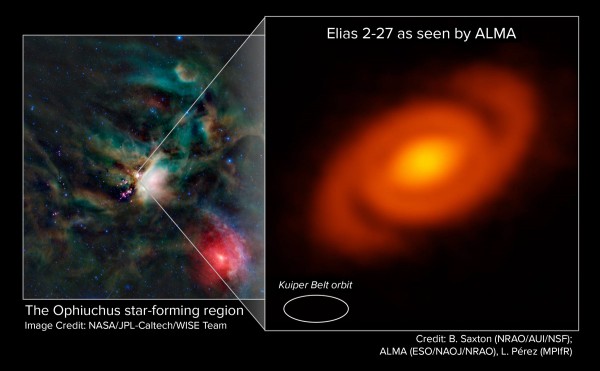By Ana Verayo, | October 03, 2016

ALMA peered into the Ophiuchus star-forming region to study the protoplanetary disk around the young star Elias 2-27.
Astronomers have spotted a baby star that is still forming courtesy of the ALMA (Atacama Large Millimeter Array) observatory in Chile, offering new insight into planet formation.
Newest observations specifically revealed spiral arms forming in a large accretion disk that enshrouds this newly-born star, known as Elias 2-27.
Like Us on Facebook
These spiral arms stretching out of Elias 2-27 are estimated to be 450 light years away from our solar system, located in the constellation Ophiuchus that spans six million miles. The Milky Way galaxy is also composed of these distinct spiral arms. However, astronomers find this interesting as these arms can also be found the midplane region of the disk more commonly known as the habitable zone where planets can form.
According to the lead author of the study, Laura M. Pérez from the Max Planck Institute for Radio Astronomy, these spirals are the first direct evidence of spiral density waves inside a protoplanetary disk. This means that these density instabilities are possible occurrences within the disk, leading to strong disk "inhomogeneities" that can trigger planet formation.
When it comes to planet formation, scientists explain that particles collide with one another and combine material together to create larger particles in the protoplanetary disk of gas and dust that surrounds a newborn star.
However, it is still a mystery how these planetary material ultimately form together in a specific region of the disk. For example, planetary material can migrate to this region for thousands of years, where gas giants such as Jupiter and Saturn can form.
In this new study, astronomers suggest how the presence of spiral arms in the protoplanetary disk of a baby star can speed up planet formation. This is due to high-density particles and material that can increase the odds of collision and combine gas and dust, with the help of gravitational forces.
Researchers now believe that these new observations of inhomogeneous structures in these disks that surround new stars can indicate a more active planetary formation process.
This new study has been published in the journal, Science.
-
Use of Coronavirus Pandemic Drones Raises Privacy Concerns: Drones Spread Fear, Local Officials Say

-
Coronavirus Hampers The Delivery Of Lockheed Martin F-35 Stealth Fighters For 2020

-
Instagram Speeds Up Plans to Add Account Memorialization Feature Due to COVID-19 Deaths

-
NASA: Perseverance Plans to Bring 'Mars Rock' to Earth in 2031

-
600 Dead And 3,000 In The Hospital as Iranians Believed Drinking High-Concentrations of Alcohol Can Cure The Coronavirus

-
600 Dead And 3,000 In The Hospital as Iranians Believed Drinking High-Concentrations of Alcohol Can Cure The Coronavirus

-
COVID-19: Doctors, Nurses Use Virtual Reality to Learn New Skills in Treating Coronavirus Patients







